The Cincet Trail

Access
Da Milano ad Ardenno (SO) lungo le SS 36 e 38. Alla rotonda all'altezza della stazione ferroviaria si svolta a sinistra e si cerca parcheggio nella zona del municipio.
Introduction
To clarify: Cincet (or Ciancet) in Valtellinese dialect is the chapel or santella, the small devotional construction that was built along the main routes in our mountains. In addition to their religious utility, cincets also had a signalling function: they indicated points of departure or arrival, crossroads, difficult or dangerous passages, or more simply characterised a locality by becoming a place name. The etymology of the noun is obscure: perhaps it may refer to the dialectal "incìnet", bow down, an imperative exhortation to devout passers-by. The municipality of Ardenno decided a few years ago (2000) to highlight this heritage of popular religious art to tourists by organising existing paths in a ring around the main 'monuments'. Unfortunately, the state of conservation is almost always poor and the few restorations are questionable. The signage is also rather poor: a few posts are not always in the appropriate places and white arrows on the ground are now faded. It is therefore advisable to study well the descriptive panel that we encounter along the route and which is reproduced here.
Description
From the town hall, we turn uphill and immediately, on the corner of a building, we notice the first signpost: San Lucio - Piazzalunga. It is essential to follow the white arrows on the ground. One ascends the paved road and meets the buildings and gardens of Palazzo Parravicini; a little further on is a cincet with the Madonna on the Throne. Having reached the tarmac road that climbs to Gaggio, follow it through chestnut woods and mowing meadows to a hairpin bend near a small ANA headquarters. Take a little path that fords two watercourses in the woods; you reach the few houses with a small church in the San Lucio district and then return to the woods that encroach on old terracing. We come across the Cincet del Mut (the mute, who apparently lived in the houses not far away), and immediately afterwards the Cincet de la Mort (Christ's Deposition from the Cross); we choose the path to the right and, just before coming out at Piazzalunga, we encounter the Cincet della Crocifissione (a former votive offering). The small hamlet, which can be reached by car from Valmàsino, is characterised by the small church of Sant'Abbondio, a few restored huts and another Cincet, the Cincet dal Pràa ('of those in the meadow', the nickname of the family who commissioned it). Back on the grassy churchyard, take the right-hand path, which descends to a sheep pen, then follows it and enters the woods until you reach the last (eastwards) houses of the contrada Scheneno. Here one encounters directional problems: one can see the church of San Giovanni Battista below, but cannot reach it; taking a direct path, one gets closer, but eventually it is necessary to walk along tracks and ladders to the vineyards that descend near the destination. The church, which can only be inspected through a high side window, has a beautiful altar typical of the area: a floral inlay of polychrome marble is simulated with the skilful use of scagliola. From here a steep asphalted track starts, which soon leads to the western edge of Ardenno after passing a farmhouse. Following the tarmac road, we head in the right direction towards the starting point.
.